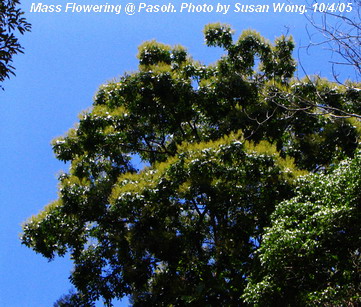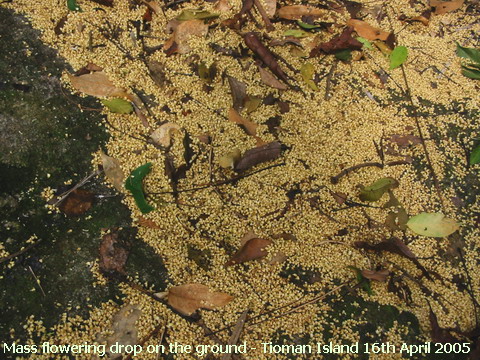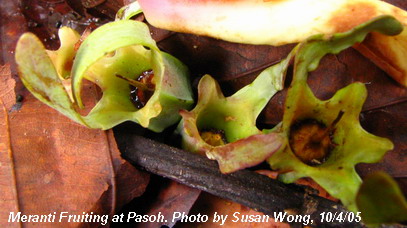|
|
|
Welcome To
Canopy
Rainforest Article Page
|
|
The
Forest Canopy
|
|
The canopy is the richest region of the diverse rainforest, and ranges in
thickness from 10-40 feet (3-12 m). Countless species, usually considered
ground dwellers, have adapted to life in the canopy-including worms, crabs,
frogs, kangaroos, anteaters, and porcupines-where they feed on the abundance
of fruits, seeds, and leaves or the numerous animals that are attracted
these foods. The plant life of the canopy is nearly as rich due to the
variety of epiphytes and lianas. |

|
CANOPY TREES
|
As a result of the crowded growing conditions, canopy trees only branch near
the top of their long, pole-like trunks (which also make them good for
timber). Because of there is no shortage of sunlight for the uppermost
leaves of canopy trees the exposed leaves are generally small and waxy to
retain water. The leaves of the lower canopy branches, shaded from the harsh
sun by the upper canopy ceiling, are often a darker blue-green color than
the leaves of the upper canopy in order to absorb the red wavelengths
necessary for photosynthesis. This red-wavelength light is generally missed
by the upper leaves, which have chlorophyll pigment for capturing shorter
wavelength light. Due to the lower light levels and differing types of light
in the mid canopy, the plants of this region and below have a greater
variety of colors than the uniform sea of green as observed from above. New
leaves in the canopy are generally not produced continuously, but instead,
like fruits and seeds, often are produced in flushes of new growth. This
feature helps protect young, vulnerable leaves by swamping leaf-predators.
Sometimes new leaves are red or white in color warning leaf-eaters of the
presence of distasteful compounds.
Unlike the overstory trees, the trees of the canopy cannot depend on wind
for spreading their seeds, so they rely primarily on animals for dispersal
and pollination. Insects are one of the largest groups responsible for
flower pollination because many plant and insect species co-evolved together
and today play intimate roles in the life cycles of each other. In fact it
is estimated that 30 unique species of insect may be dependent on each
species of tree. In turn, a tree species may be dependent on a number of
species to complete its life cycle: a bat for pollination, and a bird to
disperse and process its seeds. If the critical bat or bird is removed from
the system, the tree may no longer propagate and the species may die out in
the area. |

|
Flowering
Phenomenal
|
|
Because there are no true seasons in equatorial
rainforest, there is often no predictable flowering or fruiting season where
all the trees of the forest may bloom, bear fruit, or shed all leaves.
Instead, the flowering cycles of lowland canopy trees may seem random and
without obvious pattern. Although something must trigger flowering, the
mechanisms for most species are still largely unknown. For a few species the
mystery been solved. The stimulus that triggers flowering can range from
fire to species that flower after an especially rainy year. During a "Dipterocarp
year" in Southeast Asia, the canopy erupts in color as numerous emergent
Dipterocarp trees flower almost simultaneously.
These "mast flowerings" at
irregular intervals (once or twice per decade) may be a mechanism to swamp
seed predators with so many of the large, energy-rich seeds [individual
trees may have 120,000 fruits] that many seeds escape predation.
Additionally the random nature of flowering means no seed predator has the
opportunity to specialize on dipterocarp seeds. The principle pollinators of
diperocarps - small insects known as thirps - have a short life cycle well
adapted to the random flowering cycle of these trees. During the intervals
between mast flowering events sparse thirp populations are sustained by
feeding on understory flowers. When a mass flowering is triggered [studies
show a strong correlation between flowering and droughts/el Ni-o events] the
thirp population increases exponentially to take advantage of the massive
number of flowers [about four million flowers per tree]. |

|
Since as many as 70-90% of canopy tree species depend on animals for
pollination and seed dispersal, numerous species are equipped with special
mechanisms to ensure the proper species will take and deposit pollen in the
proper plant species and disperse seeds in a suitable place. Plants
pollinated by certain animals often have certain characteristics. For
example, flowers pollinated by birds have brightly colored, cup-shaped
flowers, while flowers pollinated by bats are often white nocturnal blooms
with copious amounts of nectar. Flowers pollinated by flies often have a
rotting or mildew-like smell just as "bee-flowers" have a sweet odor.
Butterfly flowers have a mild odor and are red or orange, since butterflies
are one of few insects with good color vision. These flowers are most common
in light gap and forest edge plants species, so butterflies tend to be most
abundant in these areas.
|
|
Due to the great diversity of flowering plant species in the rainforest, no
one species dominates. Therefore it is sometimes difficult for a particular
species, say bee species, to sustain itself feeding on the nectar of one
species of tree. It may feed on the nectar of several species of tree within
the same family. However, by doing this, there is a great risk of
hybridization and much wasted pollen. Coevolution - the process where a
trait in species A has evolved to a trait in species B, which had previously
been affected by a trait in species A - has reduced this problem. The flower
of one plant species (call it species A) has structures to deposit pollen on
one particular part of the bee, maybe its left back leg. When the bee visits
another species (call it species B), the pollen from species A will remain
on the bee"s left back leg without being deposited in flower B. In the
meantime, species B may plant its pollen on the upper part of the bee"s
right wing. As the bee flies away from flower B, it will have pollen from
both flower B and the previous flower it visited. When the bee lands in
another flower A, the flower picks up the pollen off the bee’s left hind leg
because it is equipped with an apparatus to do so, and the flower is
pollinated. |

|
Bees are one of the major insect groups responsible for pollination of
rainforest trees. Plant species are often highly specialized to be
pollinated by one unique species of bee. For example, the Castanharanas
tree, a relative of Brazil nut tree, have flowers with spring-hood covers
which must lifted to get nectar. In the process, the bees are brushed with
pollen, so when they visit the next Castanharanas flower, the bee pollinates
it. Many bees use "buzzing" to get the flower to release pollen. The flower
only releases pollen when the bee beats its wings at the right frequency,
thus only certain bees species can harvest the pollen of specific plant
species. Bees recognize color, odor, and shape and flowers pollinated by
bees are often yellow, while, or blue with a showy shape.
|
 |
|
Insect
|
The insects of the order Lepidoptera, better known as butterflies and moths,
contribute to the continuance of canopy trees, among many other plant
species. The Lepidoptera order is the second largest order after Coleoptera
(the beetles) with over 150,000 member species encompassing about 80
families. Most people think of butterflies (17,500 species over 14
families-Robbins and Opler 1997) as primary pollinators, but moths (130,000
species over 65 families), too, have an important role in pollination. For
example, the Piranha tree is pollinated by moths, just after the peak of the
Amazonian flood season, when the tree loses all of its leaves and new ones
appear immediately. The new crop of young leaves is soon completely covered
with moth caterpillars. Once tree is stripped, caterpillars form cocoons
which are suspended from the tree branches. The tree produces a second crop
of leaves, untouched by the caterpillars, now in the pupal stage of
development. The adult moths emerge from the cocoons and pollinate the
flowers. Moths, being nocturnal, are attracted to dull white to yellow
flowers that open and release odor after sunset.
Flies are important pollinators of forest flowers and are attracted by the
rot-like odor produced by some flowers. Small flies (Drosophilids) are
common pollinators of tiny orchid blooms that have an odor like decaying
matter.
Beetles are pollinators with a good sense of smell and are attracted to
odors of fermentation, spice, and fruit. Much is still unknown about the
significance of beetle pollination in the forest, although with the
incredible diversity of beetles, over 400,000 described species (making up
about 25% of all described species on earth), they probably play an
important role. One example is a beetle species that pollinates a species of
canopy tree, Annona. Annona flowers produce an odor after sundown that
attracts beetles and flies which must push through the flower petals. Once
the flower is penetrated, pollen is released on insects. The petals drop off
at dawn and the pollen-covered insects fly away to another flower the next
evening.
Birds are important pollinators, and the hummingbirds of the New World and
their Old World counterparts, the sunbirds, are attracted to flowers with
large, cup-like flowers with bright colors and large amounts of sweet
nectar. Hummingbirds are able to avoid the problem that afflicts most nectar
feeding birds: finding a suitable perch, by having the ability to beat their
wings fast enough to hang in the air. Birds are showered, marked, or even
stabbed with pollen when they arrive to feed.
Although most people do not think of mammals as pollinators, they play a
crucial role in both pollination and seed dispersal of rainforest trees.
Bats are the most important pollinators among mammals in the rainforest.
Bats, active at night, are attracted primarily to nocturnal blooms with a
strong, musty odor and generous amounts of nectar. Fruit bats of the New
World and Flying Foxes of the Old World are responsible pollination and seed
dispersal of many canopy trees. Other mammals known to pollinate plants are
Australian/Papuan marsupials, rodents, and primates. |

|
Last
Spotted updated, 10 April 2005 (Time to walk into rainforest)
Source from http://rainforests.mongabay.com/
|
|
|
|
|
We need to put this advertisement to have more
source of income for this challenging economic melting.
|
|
|
|